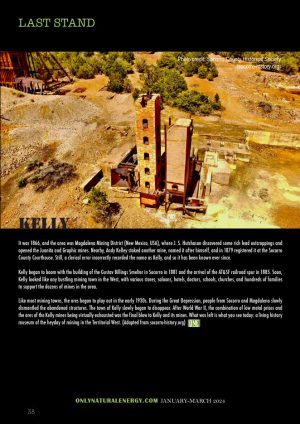 It was 1866, and the area was Magdalena Mining District (New Mexico, USA), where J. S. Hutchason discovered some rich lead outcroppings and opened the Juanita and Graphic mines. Nearby, Andy Kelley staked another mine, named it after himself, and in 1879 registered it at the Socorro County Courthouse. Still, a clerical error incorrectly recorded the name as Kelly, and so it has been known ever since.
It was 1866, and the area was Magdalena Mining District (New Mexico, USA), where J. S. Hutchason discovered some rich lead outcroppings and opened the Juanita and Graphic mines. Nearby, Andy Kelley staked another mine, named it after himself, and in 1879 registered it at the Socorro County Courthouse. Still, a clerical error incorrectly recorded the name as Kelly, and so it has been known ever since.
Kelly began to boom with the building of the Gustav Billings Smelter in Socorro in 1881 and the arrival of the AT&SF railroad spur in 1885. Soon, Kelly looked like any bustling mining town in the West, with various stores, saloons, hotels, doctors, schools, churches, and hundreds of families to support the dozens of mines in the area.
Like most mining towns, the ores began to play out in the early 1930s. During the Great Depression, people from Socorro and Magdalena slowly dismantled the abandoned structures. The town of Kelly slowly began to disappear. After World War II, the combination of low metal prices and the ores of the Kelly mines being virtually exhausted was the final blow to Kelly and its mines. What was left is what you see today: a living history museum of the heyday of mining in the Territorial West. (Adapted from socorro-history.org)



